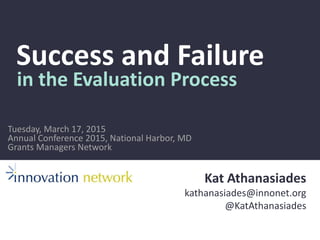
Success and Failure in the Evaluation Process
- 1. Success and Failure in the Evaluation Process Kat Athanasiades kathanasiades@innonet.org @KatAthanasiades Annual Conference 2015, National Harbor, MD Grants Managers Network Tuesday, March 17, 2015
- 2. About Innovation Network White papers with tips for grantmakers Kat Evaluation consulting firm working with foundations and nonprofits Research on evaluation practice
- 3. What does success mean to you? To your employer?
- 4. What does failure mean to you? To your employer?
- 8. Agenda Evaluation and grant reports 1 2 3 Evaluation and failure Embedding “failure reporting” in grant reports
- 9. Embedding “failure reporting” in grant reports Evaluation and grant reports 1 2 3 Agenda Evaluation and failure
- 12. Risk tolerance 1
- 13. 1
- 15. 1
- 16. 1 How tolerant is your comes to failure? organization when it
- 17. Embedding “failure reporting” in grant reports Evaluation and failure1 2 3 Agenda Evaluation and grant reports
- 20. 2
- 21. Planning What does it take to achieve goals? To achieve success? Which strategies are most effective in moving our organization closer to our long-term goal of creating meaningful experiences? 2 Why are some grantees making more progress than others?
- 22. Basic Grantee Information Grantee Name Grant Amount Topic Area Grant Terms Accountability Assessment Key Deliverables/Activities Outputs Barriers/Opportunities Staff involvement Grant report example 12
- 23. Impact/Success Assessment Change Agent Targeted Evidence of Influence Recommended Next Steps Additional Follow Up Recommended No Follow Up Grant report example 12
- 24. 1. Describe your organization’s advocacy activities and how these activities relate to your organization’s advocacy objectives 2. Describe your accomplishments in the first year of GSA funding. What advocacy related results have occurred in connection with MFH funding? Grant report example 22
- 25. 3. How have the GSA grant funds increased your organization’s capacity to perform advocacy activities? 4. What have been your organization’s challenges (frustrations, barriers, or disappointments) in the past year? How were these challenges addressed or redirected? Grant report example 22
- 26. Organization Outcomes Accomplishments Activities Successes Changing context—external factors Evidence of influence Grant report example 3 Updates on: 2
- 27. Why is it so hard to use grant reports for evaluation?
- 28. 2 The shoe (data) doesn’t fit
- 29. Planning Data collection Analysis & Reflection Action & Improvement 2 This is where grant reports are often useful
- 30. Planning Data collection Analysis & Reflection Action & Improvement 2 We often lack the data for the latter stages of evaluation
- 31. 2 Trust
- 32. 2 What pieces of your reports can be useful organization’s grant to evaluators?
- 33. Evaluation and grant reports Evaluation and failure1 2 3 Agenda Embedding “failure reporting” in grant reports
- 34. 3 Adjust the reporting structure Adjust the fields
- 35. 3 Encourage risk tolerance Build trust with grantees Build trust with board
- 36. Agenda Evaluation and grant reports 1 2 3 Evaluation and failure Embedding “failure reporting” in grant reports
- 37. What are your grantmaking failures suggestions for capturing as well as successes?
- 38. Success and Failure in the Evaluation Process Kat Athanasiades kathanasiades@innonet.org @KatAthanasiades Thank you!
- 39. Image credits Slide Credit 5-6 Desk pictures c/o Kat Athanasiades 7 Children in cafeteria from USDAgov flickr, Creative Commons: http://www.flickr.com/photos/usdagov/7995804478/ 12 Roulette from Scott Beale / Laughing Squid flickr, Creative Commons: laughingsquid.com or http://www.flickr.com/photos/laughingsquid/5249116537 13-14 Spotlight/light hole from abooth202 flickr, Creative Commons: http://www.flickr.com/photos/abooth202/2628358466 15 Mountain landscape c/o Kat Athanasiades 20-21 Road map from sidelong flickr, Creative Commons: http://www.flickr.com/photos/sidelong/234192777/ 28 Child in shoes from rumpleteaser flickr, Creative Commons: http://www.flickr.com/photos/rumpleteaser/2940847467 31 Man and tiger from dobs flickr, Creative Commons: http://www.flickr.com/photos/dobs/10726756606 34 Cranes from 96dpi flickr, Creative Commons: http://www.flickr.com/photos/96dpi/3227807209 35 Kitten and hedgehog from elenitaspics flickr, Creative Commons: https://www.flickr.com/photos/elenitaspics/11254227916
